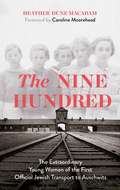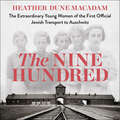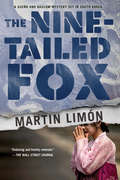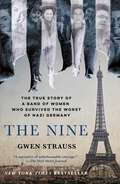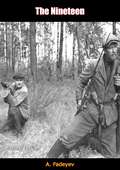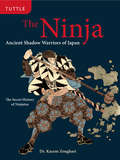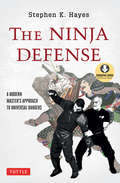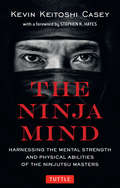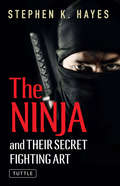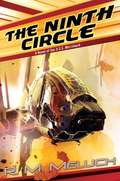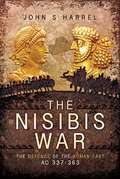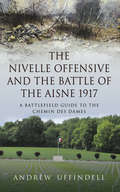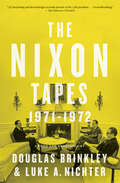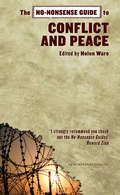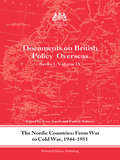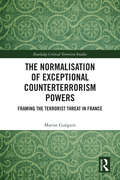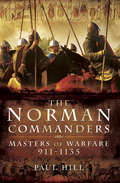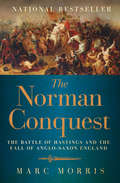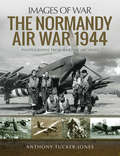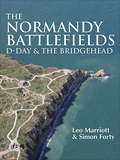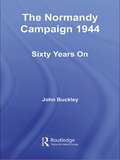- Table View
- List View
The Nine Hundred: The Extraordinary Young Women of the First Official Jewish Transport to Auschwitz
by Caroline Moorehead Heather Dune Macadam'Books such as this are essential: they remind modern readers of events that should never be forgotten' - Caroline MooreheadOn March 25, 1942, nearly a thousand young, unmarried Jewish women boarded a train in Poprad, Slovakia. Filled with a sense of adventure and national pride, they left their parents' homes wearing their best clothes and confidently waving good-bye. Believing they were going to work in a factory for a few months, they were eager to report for government service. Instead, the young women-many of them teenagers-were sent to Auschwitz. Their government paid 500 Reichsmarks (about £160) apiece for the Nazis to take them as slave labour. Of those 999 innocent deportees, only a few would survive.The facts of the first official Jewish transport to Auschwitz are little known, yet profoundly relevant today. These were not resistance fighters or prisoners of war. There were no men among them. Sent to almost certain death, the young women were powerless and insignificant not only because they were Jewish-but also because they were female. Now, acclaimed author Heather Dune Macadam reveals their poignant stories, drawing on extensive interviews with survivors, and consulting with historians, witnesses, and relatives of those first deportees to create an important addition to Holocaust literature and women's history.
The Nine Hundred: The Extraordinary Young Women of the First Official Jewish Transport to Auschwitz
by Caroline Moorehead Heather Dune MacadamThe untold story of the 999 young, unmarried Jewish women who were tricked into boarding a train in Poprad, Slovakia on March 25, 1942 that became the first official transport to Auschwitz.On March 25, 1942, nearly a thousand young, unmarried Jewish women boarded a train in Poprad, Slovakia. Filled with a sense of adventure and national pride, they left their parents' homes wearing their best clothes and confidently waving good-bye. Believing they were going to work in a factory for a few months, they were eager to report for government service. Instead, the young women-many of them teenagers-were sent to Auschwitz. Their government paid 500 Reichsmarks (about £160) apiece for the Nazis to take them as slave labour. Of those 999 innocent deportees, only a few would survive.The facts of the first official Jewish transport to Auschwitz are little known, yet profoundly relevant today. These were not resistance fighters or prisoners of war. There were no men among them. Sent to almost certain death, the young women were powerless and insignificant not only because they were Jewish-but also because they were female. Now, acclaimed author Heather Dune Macadam reveals their poignant stories, drawing on extensive interviews with survivors, and consulting with historians, witnesses, and relatives of those first deportees to create an important addition to Holocaust literature and women's history.With an introduction from the author, and a final note written and read by Edith Friedman Grosman.(P)2020 Hodder & Stoughton Limited
The Nine-Tailed Fox (A Sergeants Sueño and Bascom Novel #12)
by Martin LimónMartin Limón’s series set in 1970s South Korea, an era of heightened Korean sociopolitical tension, pits Army CID agents Sueño and Bascom against a mysterious woman who may be the leader of a gang—or a thousand-year-old creature.Three American GIs have gone missing in different South Korean cities. Sergeants George Sueño and Ernie Bascom, agents for the Army CID, link the disappearances to a woman locally rumored to be a gumiho, a legendary thousand-year-old nine-tailed fox disguised as a woman. George suspects that the woman is no mythical creature, but a criminal who’s good at covering her tracks. Meanwhile, George and Ernie are caught in a power struggle between two high-ranking women in the 8th Army. Scrambling to appease his boss and stay one step ahead of a psychotic mastermind, George realizes he will have to risk his life to discover the whereabouts of his fellow countrymen.
The Nine: The True Story of a Band of Women Who Survived the Worst of Nazi Germany
by Gwen StraussTHE BELOVED NEW YORK TIMES BESTSELLER"[A] narrative of unfathomable courage" ―Wall Street JournalThe Nine follows the true story of the author’s great aunt Hélène Podliasky, who led a band of nine female resistance fighters as they escaped a German forced labor camp and made a ten-day journey across the front lines of WWII from Germany back to Paris."I almost didn't finish this book. Not because it wasn't extraordinary—but because it was too extraordinary. Because somewhere around the third chapter, I realized I was holding my breath, terrified that if I exhaled too loudly, these nine women might disappear like smoke, like so many others did...They made promises to each other's children they'd never met, memorized addresses of families they might never find, carried letters for lovers who were probably already dead. They survived not in spite of love but because of it." —The Book NookThe nine women were all under thirty when they joined the resistance. They smuggled arms through Europe, harbored parachuting agents, coordinated communications between regional sectors, trekked escape routes to Spain and hid Jewish children in scattered apartments. They were arrested by French police, interrogated and tortured by the Gestapo. They were subjected to a series of French prisons and deported to Germany. The group formed along the way, meeting at different points, in prison, in transit, and at Ravensbrück. By the time they were enslaved at the labor camp in Leipzig, they were a close-knit group of friends. During the final days of the war, forced onto a death march, the nine chose their moment and made a daring escape.Drawing on incredible research, this powerful, heart-stopping narrative from Gwen Strauss is a moving tribute to the power of humanity and friendship in the darkest of times.
The Nineteen
by R. D. Charques A. FadeyevRazgrom (literally: devastation, debacle), here translated under the title of The Nineteen, was Russian author Alexander Fadeyev’s third novel. It has been widely acclaimed in Russia as one of the best novels of that decade and a significant artistic embodiment of revolutionary faith in a new Russia. A story of youthful guerrilla fighters it still stands as a fine work of modern Russian literature.
The Ninja
by Kacem ZoughariOften translated as "the art of remaining unseen," Ninjutsu has a long history, and is probably the most renowned and misunderstood of all martial arts. Still an active school, Ninjutsu continues to thrive today, and the idea of the ninja as a black-clad "super spy," combat master and secrecy expert continues to hold power over the imaginationDespite its popularity, the history of Ninjutsu is still murky, its origins surrounded by mystery and legend. But for the first time, The Ninja: Ancient Shadow Warriors of Japan furnishes an in-depth, factual look at the entire art of Ninjutsu, including the emergence of the Ninja warriors and philosophy in feudal Japan; detailed historical events; its context in the development of other schools of martial arts; and the philosophies and exercises of the school today.
The Ninja
by Kacem ZoughariOften translated as "the art of remaining unseen," Ninjutsu has a long history, and is probably the most renowned and misunderstood of all martial arts. Still an active school, Ninjutsu continues to thrive today, and the idea of the ninja as a black-clad "super spy," combat master and secrecy expert continues to hold power over the imaginationDespite its popularity, the history of Ninjutsu is still murky, its origins surrounded by mystery and legend. But for the first time, The Ninja: Ancient Shadow Warriors of Japan furnishes an in-depth, factual look at the entire art of Ninjutsu, including the emergence of the Ninja warriors and philosophy in feudal Japan; detailed historical events; its context in the development of other schools of martial arts; and the philosophies and exercises of the school today.
The Ninja Defense
by Stephen K. Hayes[In The Ninja Defense, the classic art of the ninja is updated for maximum effectiveness in modern day situations. Stephen K. Hayes is a Black Belt Hall of Fame member and acknowledged "Father of American Ninjutsu." He has distilled and refined the knowledge he has built studying and teaching ninjutsu for decades into a comprehensive self-defense system that can defuse the worst situations the modern world has to offer.The result is a realistic martial arts training system that includes instruction in techniques and strategies for dealing with:- grappling, throwing, choking, and joint-locking- striking, kicking, and punching- stick, blade, cord, and projectile weapons- handling multiple assailants and surprise attacks- overcoming psychological intimidation or bullying]With his revised take on the classical ninja martial arts, the author provides his readers with all the key ingredients-both physical and mental-to emerge safely from unexpected danger. The chapter on mental discipline will allow readers to feel more confident in whatever situation everyday life brings.[ The Ninja Defense contains extremely practical techniques that the author honed while serving as a bodyguard for His Holiness the Dalai Lama and fine-tuned through years of teaching. It is the ultimate self-defense book from a true martial art master.]
The Ninja Defense
by Stephen K. Hayes[In The Ninja Defense, the classic art of the ninja is updated for maximum effectiveness in modern day situations. Stephen K. Hayes is a Black Belt Hall of Fame member and acknowledged "Father of American Ninjutsu." He has distilled and refined the knowledge he has built studying and teaching ninjutsu for decades into a comprehensive self-defense system that can defuse the worst situations the modern world has to offer.The result is a realistic martial arts training system that includes instruction in techniques and strategies for dealing with:- grappling, throwing, choking, and joint-locking- striking, kicking, and punching- stick, blade, cord, and projectile weapons- handling multiple assailants and surprise attacks- overcoming psychological intimidation or bullying]With his revised take on the classical ninja martial arts, the author provides his readers with all the key ingredients-both physical and mental-to emerge safely from unexpected danger. The chapter on mental discipline will allow readers to feel more confident in whatever situation everyday life brings.[ The Ninja Defense contains extremely practical techniques that the author honed while serving as a bodyguard for His Holiness the Dalai Lama and fine-tuned through years of teaching. It is the ultimate self-defense book from a true martial art master.]
The Ninja Mind: Harnessing the Mental Strength and Physical Abilities of the Ninjutsu Masters
by Stephen K. Hayes Kevin Keitoshi CaseyEnter the mind of one of ninjutsu's greatest teachers and start your journey towards martial arts mastery!Masters in the Japanese martial art of Ninjutsu are legendary for their ability to access seemingly endless amounts of pure strength and mental endurance to achieve their goals. The Ninja Mind documents Ninjutsu black belt Kevin Casey's journey toward mastery under the tutelage of Stephen K. Hayes, Black Belt Hall of Fame member and the "Father of American Ninjutsu." Casey vividly describes his successes and setbacks studying with his famous teacher--as well as his growing interest in the Ninja art of kuji-no-ho, the most esoteric of traditional Ninja practices.Combined with determination and discipline, Casey's techniques and exercises will guide you to acquire and cultivate a true ninja's power. Exercises such as 'The Unbendable Arm' and 'Manifesting Power' will develop your physical strength, while 'Walking as the Hero' will hone the mindset necessary to overcome any challenge, no matter how suddenly it arises.Chapters in this ninjutsu guide include:The Nine PowersThe Secrets ToldPhysical Strength Mental StrengthSpirit Strength Negative Emotions
The Ninja and Their Secret Fighting Art
by Stephen K. HayesIn feudal Japan, ninja warriors were credited with supernatural powers of invisibility and ways of learning any secret. They also were feared for their skill in espionage and assassination. Behind these legends is the reality of an ancient, sophisticated, highly systematic martial art: ninjutsu. Perhaps the least understood martial art of Japan, ninjutsu emphasizes naturalness of movement, responsiveness to one's adversary, and total practicality. Women as well as men were trained in this obscure deadly art. As its form crystallized, practitioners established an organized system for maintaining absolute secrecy. Now, all aspects of ninjutsu are revealed in this remarkable book written by the first American trained as a ninja.
The Ninja and Their Secret Fighting Art
by Stephen K. HayesIn feudal Japan, ninja warriors were credited with supernatural powers of invisibility and ways of learning any secret. They also were feared for their skill in espionage and assassination. Behind these legends is the reality of an ancient, sophisticated, highly systematic martial art: ninjutsu. Perhaps the least understood martial art of Japan, ninjutsu emphasizes naturalness of movement, responsiveness to one's adversary, and total practicality. Women as well as men were trained in this obscure deadly art. As its form crystallized, practitioners established an organized system for maintaining absolute secrecy. Now, all aspects of ninjutsu are revealed in this remarkable book written by the first American trained as a ninja.
The Ninja: Ancient Shadow Warriors of Japan (The Secret History of Ninjutsu)
by Kacem ZoughariNinjutsu is the most renowned and misunderstood of all martial arts. The long history of ninjutstu is often murky; surrounded by mystery and legend. Here, for the first time, is an in-depth, factual look at the entire art of ninjutsu, including emergence of the ninja warriors and philosophy in feudal Japan; detailed historical events; its context in the development of other schools of martial arts; and the philosophies and exercises of the school today.Based on more than ten years of study and translation of authentic Japanese texts, including many that have never before been translated, this is the most comprehensive and accurate study on the art of ninjutsu ever written outside of Japan. This ninja book includes studies of ninjutsu history, philosophy, wisdom, and presents a wide range of information from authors, historians, chronicles and scrolls in order to foster a deep understanding of this "shadowy" art.For those who train in ninjutsu, for other martial art practitioners, for historians, and for anyone with an interest in Japanese feudal history or Japanese martial arts, The Ninja: Ancient Shadow Warriors of Japan shines a light on this enigmatic subject.
The Ninth Circle (Tour of the Merrimack #5)
by R. M. MeluchWhen peace exists between the Terran and Palatine Empires, the troops aboard the U.S.S. Merrimack are always on edge, waiting for the Roman forces to violate the treaties in a sneak attack on some unprotected corner of the galaxy. But as far as anyone can tell all is quiet in the universe. Admiral John Farragut no longer walks the decks of the space battleship he commanded for so many years, his time now spent on Earth with his wife and child. Captain Calli Carmel has taken Farragut's place on the ship they've both called home for so long, and she commands the Mack firmly and fairly. Others, too, are absent from their posts. Lieutenant Glenn Hamilton is on a well-deserved leave, traveling with her husband, Dr. Patrick Hamilton, the ship's xenolinguist. They're aboard a League of Earth Nations ship on a scientific expedition to an Earthlike world named Zoe, located at the back of beyond at the edge of the galaxy. Glenn is resigned to a quiet and boring run--a chance for Patrick to do what he does best while Glenn takes a back seat and tries not to upset the researchers, who can't abide any military presence. But when their vessel is attacked upon arrival, Glenn is forced to seize control, managing to crash-land the ship with no loss of life. Then--thanks in part to Patrick and Glenn--the expedition discovers that life on Zoe is DNA based, an extremely rare occurrence. So when alien invaders are also discovered on the planet, and they begin wreaking havoc on both the humans and native life-forms, it is only natural for Glenn Hamilton to call on the U.S.S. Merrimack for help. Meanwhile, on the Roman world of Phoenix, the hazing of a new recruit has gone horribly wrong. His untimely death leads the remaining members of his unit into permanent exile. Condemned to the hell of being considered dead to all they hold dear, they steal a cutting edge spaceship and, dubbing themselves the damned of the Ninth Circle, become pirates. Their leader is a man called Nox--formerly known as John Knox Farragut--younger brother to the admiral. Inevitably, both the Ninth Circle and the Palatine Empire find their way to Zoe. And suddenly all sides are on a collision course to determine the fate of this uniquely valuable planet....
The Nisibis War: The Defence of the Roman East AD 337–363
by John S. HarrelThis study of the Roman Empire&’s combat with its rivals to the east examines the evolution of ancient military strategy and tactics. During the Perso-Roman wars of 337-363, Roman forces abandoned their traditional reliance on a strategic offensive to bring about a decisive victory. Instead, the Emperor Constantius II adopted a defensive strategy and conducted a mobile defense based upon small frontier forces defending fortified cities. These forces were then supported by limited counteroffensives by the Field Army of the East. These methods successfully checked Persian assaults for twenty-four years. However, when Julian became emperor, his access to greater resources tempted him to abandon mobile defense in favor of a major invasion aimed at regime change in Persia. Although he reached the Persian capital, he failed to take it. In fact, he was defeated in battle and killed. The Romans subsequently resumed and refined the mobile defense, allowing the Eastern provinces to survive the fall of the Western Empire. In this fascinating study, John Harrel applies his personal experience of military command to a strategic, operational, tactical and logistical analysis of these campaigns and battles, highlighting their long-term significance.
The Nivelle Offensive and the Battle of the Aisne 1917: A Battlefield Guide to the Chemin des Dames
by Andrew UffindellThe notorious plateau of the Chemin des Dames saw some of the heaviest fighting of the First World War. Situated just 100 km north-east of Paris, it was the scene in 1917 of the bitterly-controversial Nivelle offensive, which is remembered today as one of the worst disasters in military history.For battlefield tourists, the Chemin des Dames is among the most fascinating sites on the entire Western Front, yet until now there has never been a detailed English guide to the actions that raged there in 1917. This new book by Andrew Uffindell fills that gap: as well as demolishing the many myths about the Nivelle offensive, it enables readers to explore the remarkable battlefield for themselves. Five tours supplemented by forty-six stops at individual places of interest provide an exceptional insight into the struggle for the Chemin des Dames. Illustrated with a wealth of maps and photographs, this book will be essential reading for anyone interested in the First World War.
The Nixon Tapes: 1971–1972
by Douglas Brinkley Luke NichterThe famous -- and infamous -- Nixon White House tapes that reveal President Richard Nixon uncensored, unfiltered, and in his own words President Nixon's voice-activated taping system captured every word spoken in the Oval Office, Cabinet Room, and other key locations in the White House, and at Camp David -- 3,700 hours of recordings between 1971 and 1973. Yet less than 5 percent of those conversations have ever been transcribed and published. Now, thanks to professor Luke Nichter's massive effort to digitize and transcribe the tapes, the world can finally read an unprecedented account of one of the most important and controversial presidencies in U.S. history. The Nixon Tapes, with annotations and commentary by Nichter and Professor Douglas Brinkley, offers a selection of fascinating scenes from the year Nixon opened relations with China, negotiated the SALT I arms agreement with the Soviet Union, and won a landslide reelection victory. All the while, the growing shadow of Watergate and Nixon's political downfall crept ever closer. The Nixon Tapes provides a unique glimpse into a flawed president's hubris, paranoia, and political genius.
The No-Nonsense Guide to Conflict and Peace
by Sabina Lautensach Helen Ware Deanna Iribarnegaray Peter GreenerThe twentieth century was the most bloody in history, and already conflict in this century has taken a heavy toll. Most wars are now within countries rather than between states, and often it is civilians that suffer most, especially women and children.This is an invaluable guide for students, peace groups, and activists. It examines the changing types of war, including the war on terror and ethnic conflict such as in Rwanda, the role of diplomacy and the UN, and what steps ordinary people are taking to rebuild communities. It offers ideas and inspiration for creating lasting peace.
The Nordic Countries: Documents on British Policy Overseas, Series I, Vol. IX (Whitehall Histories)
by Patrick Salmon Tony InsallThis book is a collection of diplomatic documents describing the development of British relations with the Nordic countries between the end of the Second World War and the defeat of the Labour Government in 1951. The end of the Second World War brought hopes of building a new society in Western Europe. This volume documents Foreign Office concerns about the range of problems, both multilateral and bilateral, which still remained to be resolved in the Nordic area, and describes the evolution of policies to deal with them. The Soviet Union, which in May 1945 already occupied parts of Norway and Denmark and dominated Finland, was perceived as a growing threat. The Nordic region was considered to be of significant strategic importance during this period. The documents describe the process whereby Britain attempted to encourage Scandinavian countries away from their support for neutrality and, by enlisting American support, began the process which led to the signature of the Atlantic Treaty in 1949, signed by Norway, Denmark and Iceland. They also include material describing the establishment of Information Research Department (formed to counteract Soviet propaganda) and illustrating some of its methods. Some documents not previously in the public domain have been declassified for this volume. Most are drawn from the archives of the Foreign and Commonwealth Office, but there are also a number of Prime Ministerial and Cabinet Office documents. This book will be of much interest to students of the Cold War, European history, British political history, international history and IR in general.
The Normalisation of Exceptional Counterterrorism Powers: Framing The Terrorist Threat in France (Routledge Critical Terrorism Studies)
by Marine GuéguinThis book investigates the framing of the terrorist threat in France from 2015 to 2020 as an ‘exceptional’ challenge which requires a ‘special’ public security response.The book examines how French political actors framed the terrorist threat in French political discourse from an exceptional challenge to a permanent, routine threat. It provides an in-depth critical discourse analysis of the French political narratives surrounding the activation of the ‘état d’urgence’ (state of emergency) following the 2015 Charlie Hebdo and Paris terrorist attacks, and traces this narrative until 2020. The study explores the securitisation-desecuritisation framework, showing how the normalisation of emergency powers reflects the ongoing (re)construction of terrorism within French political contexts. The work demonstrates the importance of threat framing and the securitisation of terrorism by considering the colonial legacies embedded in French counterterrorism (CT) policies. By investigating the intersection of CT political discourse, temporality, and colonial continuity, the book challenges traditional notions of exceptionalism in securitisation. It argues that the routinisation of counterterrorism measures highlights the impossibility of fully desecuritising terrorism (re-establishing the status quo), revealing how these measures are deeply rooted in France’s colonial past.This book will be of interest to students of Terrorism Studies, Critical Security Studies, French politics, and International Relations.
The Norman Commanders: Masters of Warfare, 911–1135
by Paul HillThis illustrated history sheds light on the greatest commanders of medieval Norman warfare, covering all their conquests from France to the Near East. Robert Guiscard, William the Conqueror, Roger I of Sicily, and Bohemond Prince of Antioch are just four of the exceptional Norman commanders who led their armies to victory and created their own kingdoms. Their single-minded leadership, and the skill and discipline of their armies, made them nearly unstoppable in their time. In this volume, Paul Hill studies their brilliant careers—along with those of Robert Curthose, William Rufus, Richard I of Capua and Henry I of England. In a narrative packed with detail and insight, and with a wide-ranging understanding of the fighting methods and military ethos of the period, Hill traces the course of their conquests, focusing on their leadership and achievements on the battlefield. The military context of their campaigns, and the conditions of warfare in France and England, in southern Italy and Sicily, and in the Near East, are vividly described. Among the operations and sieges covered in detail are Hastings, Bremule, Tinchebrai, Civitate, Misilmeri, Dyrrhachium, and Antioch. Paul Hill&’s accessible and authoritative account offers a fascinating portrait of these historic conflicts and the commanders who fought them.
The Norman Conquest: The Battle of Hastings and the Fall of Anglo-Saxon England
by Marc MorrisA riveting and authoritative history of the single most important event in English history: the Norman Conquest An upstart French duke who sets out to conquer the most powerful and unified kingdom in Christendom. An invasion force on a scale not seen since the days of the Romans. One of the bloodiest and most decisive battles ever fought. This new history explains why the Norman Conquest was the most significant cultural and military episode in English history. Assessing the original evidence at every turn, Marc Morris goes beyond the familiar outline to explain why England was at once so powerful and yet so vulnerable to William the Conqueror's attack; why the Normans, in some respects less sophisticated, possessed the military cutting edge; how William's hopes of a united Anglo-Norman realm unraveled, dashed by English rebellions, Viking invasions, and the insatiable demands of his fellow conquerors. This is a tale of powerful drama, repression, and seismic social change: the Battle of Hastings itself; the sudden introduction of castles and the massive rebuilding of every major church; the total destruction of an ancient ruling class. Language, law, architecture, and even attitudes toward life itself were altered forever by the coming of the Normans.
The Normandy Air War, 1944 (Images of War)
by Anthony Tucker-JonesThe Allied air forces of WWII come dramatically alive in this photographic history of D-Day and the invasion of France.In the months preceding the Normandy landings, Allied air forces played a vital role in blinding and isolating German forces in northern France. During the campaign, they supported the Allied armies in their push inland, most notably by hampering the march of Hitler’s panzer divisions and controversially bombing the ancient Norman cities of Caen and Rouen.Anthony Tucker-Jones’s photographic history is a vivid introduction to the Allied air offensive, illustrating the many famous types of aircraft employed by the RAF, USAAF and Luftwaffe. Allied bombers, such as the Halifax, Lancaster, Fortress, Liberator, Havoc and Marauder; as well as fighters and fighter-bombers, such as the Lightning, Thunderbolt, Mustang, Spitfire and Typhoon, are shown in ample detail.These images of the air war over northern France bring home in a graphic way the nature and conditions of combat flying over seventy years ago, and they emphasize the contribution of air power to the campaign.
The Normandy Battlefields: D-Day and the Bridgehead (Then And Now Ser.)
by Simon Forty Leo MarriottExperience the battlefields of D-Day in this beautiful book combining historical images, full-color aerial photography, and informative text. The D-Day invasion of Nazi-occupied Normandy was the most dramatic turning point of World War II. With a combination of historic and contemporary photography, along with maps and other illustrations, The Normandy Battlefields takes readers &“on-site&” to the sacred battlegrounds. The armada that attacked from Britain left behind many signs of their passage. The Normandy Battlefields details what can be seen on the ground today using a mixture of media to provide a complete overview of the campaign. Maps old and new highlight what has survived and what hasn&’t; then-and-now photography allows fascinating comparisons with the images taken at the time, and computer artwork provides graphic details of things that can&’t be seen today. The book describes the area from Cherbourg to Le Havre by way of the key D-Day locations, providing a handbook for the visitor and an overview for the armchair traveler. It covers the forces from both sides and the memorials to those young men who fought so many years ago.
The Normandy Campaign 1944: Sixty Years On (Military History and Policy)
by John BuckleyWith essays from leading names in military history, this new book re-examines the crucial issues and debates of the D-Day campaign. It tackles a range of core topics, placing them in their current historiographical context, to present new and sometimes revisionist interpretations of key issues, such as the image of the Allied armies compared with the Germans, the role of air power, and the lessons learned by the military from their operations. As the Second World War is increasingly becoming a field of revisionism, this book sits squarely within growing debates, shedding new light on topics and bringing current thinking from our leading military and strategic historians to a wider audience. This book will be of great interest to students of the Second World War, and of military and strategic studies in general.
